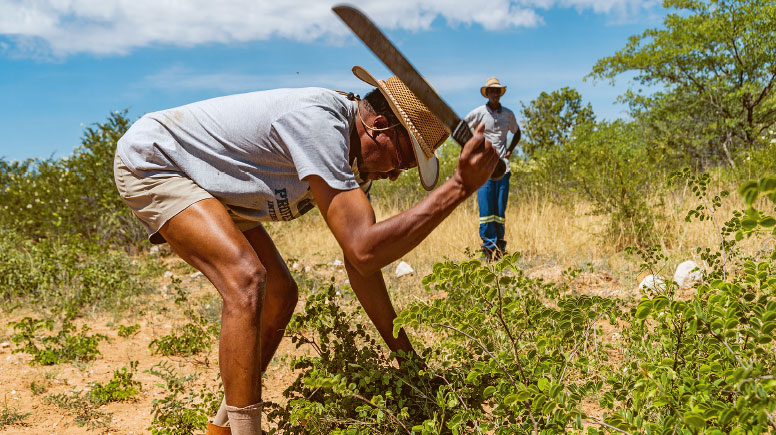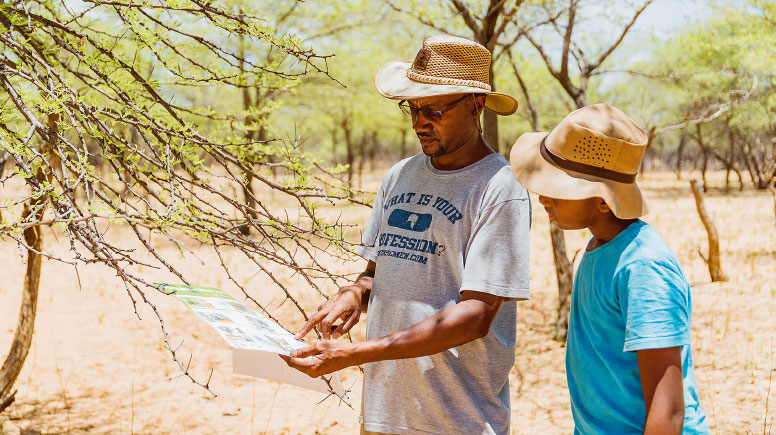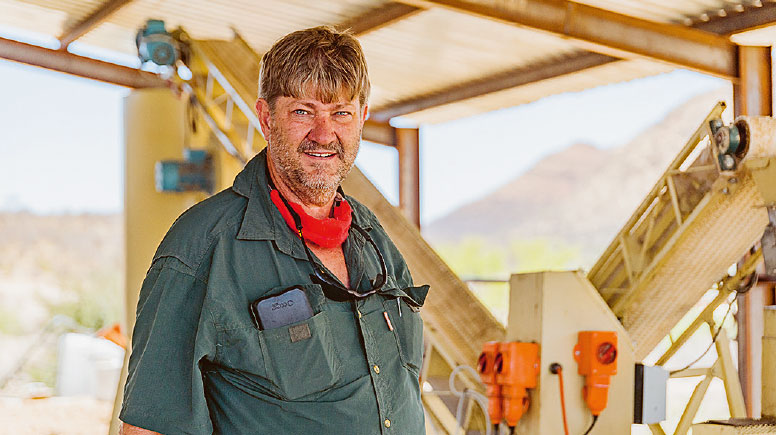Report Namibia
A prickly solution
‘When I was your age there were none of these bushes around here,’ Chief Ruben Uazukuani says to his twelve-year-old son Rusuvero as he opens the gate to the pen. His cows are already waiting. They walk off into the bush landscape and are soon out of sight. ‘You used to be able to look out over the savanna from here and you would see grass growing everywhere,’ explains the smallholder. Now his cattle struggle to search for food, as the bushes, some of which grow to the size of trees, have replaced the grass. In quite a few places the growth is actually so dense and thorny that the cows cannot get through at all, or not without injuring themselves.

Experts call this bush encroachment, a problem that affects many regions of Namibia. The bush has now expanded to cover as much as 45 million hectares of land. That is roughly the area of Germany and Austria combined. And the problem is growing: by around three per cent a year. The main reason is decades of overgrazing, explains GIZ staff member Johannes Laufs: ‘The whole process is accelerated by climate change, because with high levels of CO2 in the atmosphere the bush grows better than grass.’ The consequences for agriculture are devastating. With support from the Bush Control and Biomass Utilisation project, which is managed by Laufs, Namibia is responding to changes to its climate and is trying to boost its resilience. This is a matter of urgency, as bush encroachment has been accompanied by serious droughts in recent years. ‘Many smallholders from our region lost their livestock and were forced to move to the cities,’ Uazukuani recounts. He himself has been working in the capital Windhoek for a number of years now. It is only at weekends that he makes the approximately four-hour journey to Okamatapati, where his family farms several thousand hectares of land that he has rented from the state.

Together with his son and two workers, he drags his hammer mill out of a shed. The mill has rotating hammers, which can grind various bush materials to different degrees of fineness. He heaves it onto his pickup, and after driving a short distance the men get out, grab their machetes and start chopping off the bushes growing along the edge of the unpaved road, just above the rootstock. The bushes are showing signs of fresh growth after long-awaited rain. Uazukuani uses the mill to grind and shred the branches, and gradually the loading area of his pickup starts to fill up. ‘A good crop,’ he says. That’s because while the bush used to be viewed as nothing but a problem and in some cases was destroyed using chemicals, today it is also considered to be a valuable resource. The 47-year-old is one of over a thousand farmers who have attended workshops to learn how to produce animal feed from bush biomass. The De-bushing Advisory Service was set up by GIZ and organises the practical training courses. Several of them are held on the farm belonging to Anton Dresselhaus, who is considered a pioneer in this field in Namibia.

No one is laughing about bush feed any more
He began experimenting with formulations 10 years ago, first out of necessity and later out of conviction. ‘Many people laughed at me at the time and told me “Cows are grazing animals and don’t eat bushes,”’ he recalls. But the innovative agriculturalist proved the opposite. ‘If the bush material is fine enough and looks like grass or wool, they actually very much like eating it.’ The mix is then enriched with ingredients such as molasses, salt, urea or phosphate to provide the livestock with proteins and minerals at the same time. As well as the basic formulation, there are other special mixtures, for pregnant females, for example. Dresselhaus has documented everything in precise detail. He is pleased that his livestock put on weight faster, so can then be sold all the sooner. That saves costs. Moreover, he was able to create additional jobs for people harvesting and processing the bushes. During the drought he was nearly overwhelmed by enquiries, with demand for surplus bush feed from his production extremely high at the time.
NEW WAYS OUT OF THE BUSH
Under the influence of climate change, savannas around the world are being transformed into thickets of bush. Namibia is attempting to curb bush encroachment while simultaneously creating opportunities for agriculture and new jobs. Bush control and promoting biomass value chains are important elements of development cooperation between Namibia and Germany. GIZ’s Bush Control and Biomass Utilisation (BCBU) project, implemented on behalf of the German Development Ministry, works closely with the Namibian Ministry of Agriculture, Water and Forestry. As part of the collaboration, frameworks have been developed and put in place to utilise the bush on a sustainable basis. Along with the production of animal feed, the project supports value creation in the form of renewable energy, biochar, charcoal and building materials. A knowledge centre for farmers and entrepreneurs has been set up too – the De-bushing Advisory Service. So far an additional 5,300 jobs have been created, and during the last drought 860 farmers produced animal feed from bush biomass. Bush control measures are carried out on 300,000 hectares of land every year.
Contact: Johannes Laufs, johannes.laufs@giz.de;
Asellah David, asellah.david@giz.de
The various farmers involved now swap tales of their experiences, and have also persuaded those who were initially sceptical, such as Ruben Uazukuani. To begin with he could not believe that his cattle would ‘eat twigs’. But he was soon convinced. ‘This scheme kept my herd alive. Without the bush feed they would not have survived the last drought,’ stresses Uazukuani, as he returns to his small farm after harvesting the bush. Between the small buildings, opposite the cooking stove where the women are preparing the midday meal, lies the mixed feed which he had already spread out in the sun on plastic sheeting the previous day.

What’s good for the bull is good for the farmer
The pure shredded bush can be stored for some time, he explains, but the finished mixture has to be fed to the animals quite quickly. He fills a bucket and carries it to a trough. A young bull comes trotting up straight away and tucks into the feed. It is clear that it tastes at least as good to him as conventional feed does. Yet it is around a third cheaper, according to Uazukuani. ‘I’m saving a lot of money.’ After the recent rain, though, his herd have been feeding mainly on grass again. Only certain animals, such as those that are particularly valuable – like this bull – get the organic bush feed as an added extra, because producing it is labour-intensive and requires a degree of expertise. Uazukuani produces it himself, taking the greatest care, because getting the formulation wrong can harm the animals, and in extreme cases even kill them. ‘If I were here all the time, I would produce the feed constantly,’ he explains, ‘because it is truly excellent, more than just an emergency feedstuff.’

The same opinion is expressed by Salomo Kauari, another smallholder on communal land. After his father died, he gave up his job at an agricultural company to devote himself fully to farming. ‘The bush feed was a real revelation,’ he explains. ‘I can use lots of things that are already here on the farm to make it, or crops that I can grow myself.’ And indeed, plants such as lupin and moringa, which he adds to the feed, are growing next to his house. Bales and sacks of dried ingredients, including protein-rich seed pods from certain bush species, are stacked in a shed.
Kauari has resolved not to buy in any feed at all this year, but to make it himself. Not only because he has to drive to a bigger town about 150 kilometres away to get to the nearest business selling agricultural products or because money is short, but also because he is convinced of the quality of the feed. ‘Thanks to the bush feed none of my livestock perished during the drought, while my neighbours lost many animals in that time,’ he explains. He is now experimenting with different formulations for various uses, and doing so successfully. His plans to continue thinning the bush are just as ambitious: in the course of the year, the 45-year-old farmer is aiming to clear as much as four hectares of species that spread particularly quickly and displace the grass in the savanna. The cost of hiring two workers to do this is worth it, he declares, pointing out that ‘I’ve seen how the pasture land recovers where we’ve previously thinned the bush.’ He now uses this land to keep goats, which eat the shoots as they regrow and keep the new growth in check.
There is something else that Kauari has observed, too: his two wells now have more water in them again since he removed the bushes, some of which have deep tap roots. ‘Before, we were only able to draw water from them for a couple of hours a day, but now the levels are much higher.’ In light of this success, he has no doubt that bush-based feed is the way forward. His biggest dream is having a pellet press to produce pelleted feed, which can be stored for longer. ‘I’m already saving up to buy one. I could supply animal feed to farmers in the neighbourhood and would have another source of income.’ At the same time, his land would continue to regenerate. And perhaps, some day, the landscape will once again look like it did back when Ruben Uazukuani was a boy.
The programme contributes to the following United Nations Sustainable Development Goals (SDGs):
|
|
|
|
|
published in akzente 1/21
